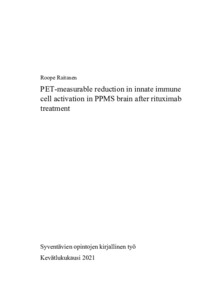PET-measurable reduction in innate immune cell activation in PPMS brain after rituximab treatment
Raitanen, Roope (2021-04-09)
PET-measurable reduction in innate immune cell activation in PPMS brain after rituximab treatment
Raitanen, Roope
(09.04.2021)
Julkaisu on tekijänoikeussäännösten alainen. Teosta voi lukea ja tulostaa henkilökohtaista käyttöä varten. Käyttö kaupallisiin tarkoituksiin on kielletty.
avoin
Julkaisun pysyvä osoite on:
https://urn.fi/URN:NBN:fi-fe2021042011099
https://urn.fi/URN:NBN:fi-fe2021042011099
Tiivistelmä
A 48-year-old woman with primary progressive multiple sclerosis (PPMS) was started on rituximab shortly after diagnosis. She underwent serial PET-imaging at an 18-month interval using [11C]PK11195, a first generation 18-kDa translocator protein ligand targeting activated brain microglia and macrophages, before and after rituximab. I participated in the study as an assistant, and I handled the first processing of the MRI images. The case report is meant to be published in Multiple sclerosis journal in 2021.
Rituximab is a monoclonal antibody, that identifies CD20-molecule on the surface of B lymphocytes. Rituximab causes apoptosis in all the cells it binds to. B-cell activation is linked to MS pathogenesis and it has been shown in studies that decreased B-cell levels correlate with better outcome clinically and radiologically in RRMS- and young PPMS patients. Rituximab does not have an official indication for treating MS, but later developed Ocrelizumab works very similarly to it and got an indication in 2018 in the European markets.
The patient remained clinically stable during a five-year follow-up, and a decrease in radioligand binding was noted in brain areas relevant to progressive MS pathology, such as perilesional white matter area and thalamus. The finding implicates that efficient and early B-cell therapy may lead to reduced microglial activation in PPMS, which may slow down later disease progression.
The case report opens new vistas for designing future therapeutic studies that use the evaluation of microglial activation as an imaging outcome measure in MS. The study is also in line with previous studies that have shown the predictive value of TSPO-PET imaging compared to conventional MRI.
Rituximab is a monoclonal antibody, that identifies CD20-molecule on the surface of B lymphocytes. Rituximab causes apoptosis in all the cells it binds to. B-cell activation is linked to MS pathogenesis and it has been shown in studies that decreased B-cell levels correlate with better outcome clinically and radiologically in RRMS- and young PPMS patients. Rituximab does not have an official indication for treating MS, but later developed Ocrelizumab works very similarly to it and got an indication in 2018 in the European markets.
The patient remained clinically stable during a five-year follow-up, and a decrease in radioligand binding was noted in brain areas relevant to progressive MS pathology, such as perilesional white matter area and thalamus. The finding implicates that efficient and early B-cell therapy may lead to reduced microglial activation in PPMS, which may slow down later disease progression.
The case report opens new vistas for designing future therapeutic studies that use the evaluation of microglial activation as an imaging outcome measure in MS. The study is also in line with previous studies that have shown the predictive value of TSPO-PET imaging compared to conventional MRI.
